The Electric Vehicle Market in Brazil: A Systematic Literature Review of Factors Influencing Purchase Decisions
Abstract
:1. Introduction
2. Electric Vehicles: Main Concepts
2.1. Electric Vehicles in Brazil
| Propositions | Menu |
|---|---|
| 710/2023 | Installation of charging points for electric and hybrid vehicles in public parking lots and public roads. |
| 1621/2022 | Determines that new electric vehicles sold in Brazil must contain a charging cable that connects to charging stations according to a nationally standardised configuration, in the form of a regulation. |
| 2397/2021 | Mandatory toll exemption for electric vehicles in future highway concession notices published by the National Land Transport Agency (ANTT). |
| 3174/2020 | Incentives for electric vehicles, based on a tax cut and a change in the federal government’s fleet. |
| 5308/2020 | Exempts imports and exports of electric or hybrid vehicles from the tax on industrialized products (IPI). |
| 3435/2019 | Mandatory installation of charging points for electric and hybrid cars in covered parking lots with more than 200 spaces. |
| 3197/2019 | Mandatory installation of charging points for electric vehicles on public roads and in residential and commercial environments. |
| 1964/2019 | Incentives to expand the use of electricity to power motor vehicles. |
| 1618/2019 | Mandatory charging points for electric vehicles in new residential buildings. |
| 874/2019 | Measures to promote an increase in the number of public charging points for electric vehicles. |
| 874/2019 | Measures to promote an increase in the number of public charging points for electric vehicles. |
| 9616/2018 | Tax incentives for the production and sale of vehicles powered exclusively or partially by electric motors. |
2.2. Electric Vehicle Market in Brazil
2.3. Factors in the Decision to Buy Electric Vehicles
3. Method
4. Results—Systematic Literature Review
- Blue cluster (3 authors): Hardman, S.; Tal G.; Axsen, J.
- Red cluster (11 authors): Fan, Y.; Zhang G.; Wang H.; Zhuge C.; Zhang Q.; Li, W; Higueras-Castillo E.; Wang Y.; Wang J.; Wang Z.; Huang Y.; Wang S.
- Green cluster (4 authors): Sovacool, K.; Noel L.; Kester, J.; de Rubens, G.
5. Results—Fuzzy Delphi
6. Conclusions
Author Contributions
Funding
Institutional Review Board Statement
Informed Consent Statement
Data Availability Statement
Acknowledgments
Conflicts of Interest
References
- Frizzo, K. Análise do impacto da gestão estratégica de Mudanças Climáticas no Modelo de Negócios Circular, na reputação Corporativa e nas Políticas Públicas. Ph.D. Thesis, da Universidade Federal de Santa Maria, Santa Maria, Brazil, 2023. [Google Scholar]
- Ellen Macarthur Foundation (EMF). Completando a Figura: Como a Economia Circular Ajuda a Enfrentar as Mudanças Climáticas. v.3. 2019. Available online: https://emf.thirdlight.com/file/24/34jSrJc344.wq9z34q-R3P-DB5B/Completando-a-figura-Como-a-economia-circular-ajuda-a-enfrentar-as-mudanc%CC%A7asclima%CC%81ticas.pdf (accessed on 28 April 2023).
- Wang, Z.; Dong, X. Determinants and policy implications of residents’ new energy vehicle purchases: The evidence from China. Nat. Hazards 2016, 82, 155–173. [Google Scholar] [CrossRef]
- Gasbarro, F.; Pinkse, J. Corporate Adaptation Behaviour to Deal with Climate C hange: The Influence of Firm-Specific Interpretations of Physical Climate Impacts. Corp. Soc. Responsib. Environ. Manag. 2015, 23, 179–192. [Google Scholar] [CrossRef]
- McCollum, D.L.; Wilson, C.; Bevione, M.; Carrara, S.; Edelenbosch, O.Y.; Emmerling, J.; Guivarch, C.; Karkatsoulis, P.; Keppo, I.; Krey, V.; et al. Interaction of consumer preferences and climate policies in the global transition to low-carbon vehicles. Nat. Energy 2018, 3, 664–673. [Google Scholar] [CrossRef]
- Nascimento, V.N.A. Análise da Tendência de Adoção dos Veículos Elétricos em Portugal: O Papel dos Atributos Instrumentais e Simbólicos. Master’s Thesis, Lusófona University of Porto, Porto, Portugal, 2021. [Google Scholar]
- EUR-LEX. Regulation (EU) 2023/851 of the European Parliament and of the Council of 19 April 2023 Amending Regulation (EU) 2019/631 to Strengthen the CO2 Emission Performance Standards for New Passenger Cars and New Light Commercial Vehicles in Line with the Union’s Increased Climate Ambition. 2023. Available online: https://eur-lex.europa.eu/legal-content/EN/TXT/?uri=CELEX:32023R0851 (accessed on 20 May 2023).
- International Energy Agency (IEA). Global EV Outlook 2017: Two Million and Counting [Brochure]. 2017. Available online: www.iea.org/media/topics/transport/Global_EV_Outlook_2017_Leaflet.pdf (accessed on 1 March 2023).
- Li, W.; Long, R.; Chen, H.; Yang, T.; Geng, J.; Yang, M. Effects of personal carbon trading on the decision to adopt battery electric vehicles: Analysis based on a choice experiment in Jiangsu, China. Appl. Energy 2018, 209, 478–488. [Google Scholar] [CrossRef]
- Kawamoto, R.; Mochizuki, H.; Moriguchi, Y.; Nakano, T.; Motohashi, M.; Sakai, Y.; Inaba, A. Estimation of CO2 Emissions of Internal Combustion Engine Vehicle and Battery Electric Vehicle Using LCA. Sustainability 2019, 11, 2690. [Google Scholar] [CrossRef]
- da Silva, J.V. Comportamento do Consumidor para uso de Automóveis Elétricos: Uma Evolução Histórica. Bachelor’s Thesis, Pontifical Catholic University of Goiás, Goiânia, Brazil, 2020. [Google Scholar]
- ANTP. Relatório Geral 2018—Sistema de Informações da Mobilidade Urbana da Associação Nacional de Transportes Públicos—SIMOB/ANTP. 2020. Available online: https://files.antp.org.br/simob/sistema-de-informacoes-da-mobilidade--simob--2018.pdf (accessed on 18 April 2024).
- de Rubens, G.Z.; Noel, L.; Sovacool, B.K. Dismissive and deceptive car dealerships create barriers to electric vehicle adoption at the point of sale. Nat. Energy 2018, 3, 501–507. [Google Scholar] [CrossRef]
- Singh, P.K.; Sarkar, P. A framework based on fuzzy Delphi and DEMATEL for sustainable product development: A case of Indian automotive industry. J. Clean. Prod. 2020, 246, 118991. [Google Scholar] [CrossRef]
- Zhao, Z. Factors Influencing the Consumption of Electric Vehicles in China. Master’s Thesis, Graduate School of Business, Siam University, Bangkok, Thailand, 2022. [Google Scholar]
- Yin, Y.-R.; Li, Y.; Zhang, Y. Influencing factor analysis of household electric vehicle purchase intention of HaiNan Free Trade Port under the background of low-carbon lifestyle. Energy Rep. 2022, 8, 569–579. [Google Scholar] [CrossRef]
- Sheng, S.M.; Wen, L.; Sharp, B.; Du, B.; Ranjitkar, P.; Wilson, D. A spatio-temporal approach to electric vehicle uptake: Evidence from New Zealand. Transp. Res. Part D Transp. Environ. 2022, 105, 103256. [Google Scholar] [CrossRef]
- He, Z.; Zhou, Y.; Wang, J.; Shen, W.; Li, W.; Lu, W. Influence of emotion on purchase intention of electric vehicles: A comparative study of consumers with different income levels. Curr. Psychol. 2022, 42, 21704–21719. [Google Scholar] [CrossRef]
- Zhang, Z.; Sheng, N.; Zhao, D.; Cai, K.; Yang, G.; Song, Q. Are residents more willing to buy and pay for electric vehicles under the “carbon neutrality”? Energy Rep. 2022, 9, 510–521. [Google Scholar] [CrossRef]
- Sriram, K.V.; Michael, L.K.; Hungund, S.S.; Fernandes, M. Factors Influencing Adoption of Electric Vehicles—A Case in India. Cogent Eng. 2022, 9. [Google Scholar] [CrossRef]
- Wang, P.; Guan, C.; Zhuge, C.; Sun, M. Characteristics and attitudes of actual electric vehicle adopters from different classes of cities. Res. Transp. Bus. Manag. 2021, 43, 100728. [Google Scholar] [CrossRef]
- Kim, S.; Choi, J.; Yi, Y.; Kim, H. Analysis of Influencing Factors in Purchasing Electric Vehicles Using a Structural Equation Model: Focused on Suwon City. Sustainability 2022, 14, 4744. [Google Scholar] [CrossRef]
- Tavares, L.P. Fatores de Aproximação e Distanciamento dos Consumidores de Veículos Elétricos. Master’s Thesis, Universidade Católica Portuguesa, Lisbon, Portugal, 2021. [Google Scholar]
- Khaleghiyaraziz, M. Fatores que Impactam a Intenção do Consumidor de Comprar Veículos Elétricos em Bangkok. Master’s Thesis, College of Management, Mahidol University, Salaya, Thailand, 2021. [Google Scholar]
- Goel, S.; Sharma, R.; Rathore, A.K. A review on barrier and challenges of electric vehicle in India and vehicle to grid optimisation. Transp. Eng. 2021, 4, 100057. [Google Scholar] [CrossRef]
- Higueras-Castillo, E.; Molinillo, S.; Coca-Stefaniak, J.A.; Liébana-Cabanillas, F. Potential Early Adopters of Hybrid and Electric Vehicles in Spain—Towards a Customer Profile. Sustainability 2020, 12, 4345. [Google Scholar] [CrossRef]
- Neves, L. Barreiras e Motivações à Compra de um Veículo Elétrico [Barriers and Motivations for the Purchase of an Electric Vehicle]. Master’s Thesis, Universidade Católica Portuguesa, Lisbon, Portugal, 2020. [Google Scholar]
- Chen, C.; de Rubens, G.Z.; Noel, L.; Kester, J.; Sovacool, B.K. Assessing the socio-demographic, technical, economic, and behavioral factors of Nordic electric vehicle adoption and the influence of vehicle-to-grid preferences. Renew. Sustain. Energy Rev. 2020, 121, 109692. [Google Scholar] [CrossRef]
- Zhuge, C.; Wei, B.; Shao, C.; Dong, C.; Meng, M.; Zhang, J. The potential influence of cost-related factors on the adoption of electric vehicle: An integrated micro-simulation approach. J. Clean. Prod. 2020, 250, 119479. [Google Scholar] [CrossRef]
- Sovacool, B.K.; Abrahamse, W.; Zhang, L.; Ren, J. Pleasure or profit? Surveying the purchasing intentions of potential electric vehicle adopters in China. Transp. Res. Part A Policy Pract. 2019, 124, 69–81. [Google Scholar] [CrossRef]
- Ma, S.-C.; Fan, Y.; Guo, J.-F.; Xu, J.-H.; Zhu, J. Analysing online behaviour to determine Chinese consumers’ preferences for electric vehicles. J. Clean. Prod. 2019, 229, 244–255. [Google Scholar] [CrossRef]
- Xu, Y.; Zhang, W.; Bao, H.; Zhang, S.; Xiang, Y. A SEM–Neural Network Approach to Predict Customers’ Intention to Purchase Battery Electric Vehicles in China’s Zhejiang Province. Sustainability 2019, 11, 3164. [Google Scholar] [CrossRef]
- Yan, Q.; Qin, G.; Zhang, M.; Xiao, B. Research on Real Purchasing Behavior Analysis of Electric Cars in Beijing Based on Structural Equation Modeling and Multinomial Logit Model. Sustainability 2019, 11, 5870. [Google Scholar] [CrossRef]
- Huang, X.; Ge, J. Electric vehicle development in Beijing: An analysis of consumer purchase intention. J. Clean. Prod. 2019, 216, 361–372. [Google Scholar] [CrossRef]
- Wang, S.; Wang, J.; Li, J.; Wang, J.; Liang, L. Policy implications for promoting the adoption of electric vehicles: Do consumer’s knowledge, perceived risk, and financial incentive policy matter? Transp. Res. Part A Policy Pract. 2018, 117, 58–69. [Google Scholar] [CrossRef]
- Axsen, J.; Cairns, J.; Dusyk, N.; Goldberg, S. What drives the Pioneers? Applying lifestyle theory to early electric vehicle buyers in Canada. Energy Res. Soc. Sci. 2018, 44, 17–30. [Google Scholar] [CrossRef]
- Sun, K.K.; He, S.Y.; Thøgersen, J. The purchase intention of electric vehicles in Hong Kong, a high-density Asian context, and main differences from a Nordic context. Transp. Policy 2022, 128, 98–112. [Google Scholar] [CrossRef]
- Abudayyeh, D.; Almomani, M.; Almomani, O.; Jaber, D.; Alhelo, E. Examining the Determinants of Electric Vehicle Acceptance in Jordan: A PLS-SEM Approach. World Electr. Veh. J. 2023, 14, 304. [Google Scholar] [CrossRef]
- Saw, K.; Kedia, A. Estimating the adoption of electric vehicles: A case study of four Indian states. Compet. Regul. Netw. Ind. 2023, 24, 120–135. [Google Scholar] [CrossRef]
- De Souza, C.C.R.; Hiroi, J. O mercado de carros elétricos no Brasil: Análise de barreiras e sugestões de expansão. Rev. Práticas Em Contab. Gestão 2021, 9, 1–19. [Google Scholar]
- França, M. Indústria Automobilística: Globalização Produtiva e Atividades de P&D; Boletim de Informações FIPE: São Paulo, Brazil, 2018; pp. 33–38. [Google Scholar]
- Schiavi, M.T. Study of Trends and Technological Developments of the Electric Car in Brazil. Doctoral Thesis, Centro de Educação e Ciências Humanas, Universidade Federal de São Carlos, São Carlos, Brazil, 2020. [Google Scholar]
- Mendoza, P., Jr. Electric Vehicle Uptake in the Kingdom of Thailand: Analysis Using Analytic Hierarchy Process. Master’s Thesis, Faculty of Informatics, Sripatum University, Bangkok, Thailand, 2018. [Google Scholar]
- Delgado, F.; Costa, J.E.G.; Febraro, J.; da Silva, T.B. Carros Elétricos [Electric Cars]; Cadernos FGV Energia 2017; FGV: Rio de Janeiro, Brazil, 2017. [Google Scholar]
- Pestana, L.F.F. Os Millennials e a Mobilidade Elétrica: Análise da Intenção de Compra de Carros Elétricos [Millennials and Electric Mobility: Analysis of the Intention to Purchase Electric Cars]. Master’s Thesis, Faculdade de Economia, Universidade do Porto, Porto, Portugal, 2020. [Google Scholar]
- International Energy Agency (IEA). Global EV Outlook 2016. OECD, 2016. Available online: https://www.iea.org/publications/freepublications/publication/Global_EV_Outlook_2016.pdf (accessed on 1 March 2023).
- Venditti, M.S. 7 Vantagens dos Carros Elétricos: Saiba Quais São os Principais Benefícios que o Veículo Eletrificado tem em Comparação ao Movido a Combustível. Estadão Mobilidade. 2020. Available online: https://mobilidade.estadao.com.br/inovacao/7-vantagens-dos-carros-eletricos/ (accessed on 1 May 2023).
- AutomotiveBusiness. Carro Elétrico no Brasil: Ousar ou Esperar. 2019. Available online: https://www.automotivebusiness.com.br/pt/artigo/1782/carro-eletrico-no-brasil-ousar-ou-esperar/ (accessed on 1 March 2023).
- Barassa, E. A Construção de uma Agenda para a Eletromobilidade no Brasil: Competências Tecnológicas e Governança [The Construction of an Agenda for Electromobility in Brazil: Technological Competences and Governance]. Doctoral Dissertation, Departamento de Política Científica e Tecnológica, Universidade Estadual de Campinas, Campinas, Brazil, 2019. [Google Scholar]
- Associação Brasileira do Veículo Elétrico (ABVE). O Futuro dos Carros Elétricos: Um Artigo para eu ler Daqui a 10 Anos [The Future of Electric Cars: An article for Me to Read in 10 Years]. 2012. Available online: https://www.abve.org.br (accessed on 1 August 2022).
- BRASIL, Projeto de Lei nº 454 de 2017. Senado Federal. Projeto de Lei do Senado nº 454 de 2017. Available online: https://www.congressonacional.leg.br/materias/materias-bicamerais/-/ver/pls-454-2017 (accessed on 1 January 2023).
- Coelho, P.; Abreu, M. Transição sociotecnológica para a mobilidade urbana sustentável no Brasil. Rev. De Adm. Da UFSM 2019, 12, 1227–1241. [Google Scholar] [CrossRef]
- Chamber of Deputies. Title of the Proposal [Legislative Proposal]. 2023. Available online: https://www.camara.leg.br/proposicoesWeb/fichadetramitacao?idProposicao=2403910 (accessed on 1 October 2023).
- Yu, X.; Sandhu, N.S.; Yang, Z.; Zheng, M. Suitability of energy sources for automotive application—A review. Appl. Energy 2020, 271, 115169. [Google Scholar] [CrossRef]
- Castro, N.J.; Ludovique, C.; Vieira, M.G.; Monteath, L.; Masseno, L.; Alves, A.; Castro, B.; Ozorio, L.; Tavares, A.; Ferreira, D. Perspectivas Para o Desenvolvimento da Mobilidade Elétrica no Brasil [Perspectives for the Development of Electric Mobility in Brazil]; Gesel: Rio de Janeiro, Brazil, 2021. [Google Scholar]
- Associação Nacional dos Fabricantes de Veículos Automotores (ANFAVEA). Anuário da Indústria Automobilística Brasileira 2022 [Yearbook of the Brazilian Automotive Industry 2022]; Editora AutoData: São Paulo, Brazil, 2022; Available online: https://www.anfavea.com.br/site/anuarios/ (accessed on 1 May 2023).
- Wolffenbüttel, R.F. Políticas setoriais e inovação: Entraves e incentivos ao automóvel elétrico no Brasil [Sectoral policies and innovation: Barriers and incentives to electric vehicles in Brazil]. Rev. Bras. De Inovação 2022, 21, e022017. [Google Scholar] [CrossRef]
- Wolffenbüttel, R. A Produção Social da Inovação: O Automóvel Elétrico e as Redes de Inovação no Brasil [The Social Production of Innovation: The Electric Vehicle and Innovation Networks in Brazil]; Cirkula: Porto Alegre, Brazil, 2021. [Google Scholar]
- Associação Brasileira do Veículo Elétrico (ABVE). Quem Somos. 2023. Available online: https://abve.org.br/quem-somos/ (accessed on 18 April 2024).
- Pereira, E.V. Tendências Tecnológicas e Mercado Atual dos Veículos Elétricos no Brasil e no Mundo [Technological trends and current market of electric vehicles in Brazil and worldwide]. Bachelor’s thesis, Universidade Federal do Ceará, Fortaleza, Brazil, 2016. [Google Scholar]
- Ministério da Economia. Rota 2030—Mobilidade e Logística. Available online: https://www.gov.br/produtividade-e-comercio-exterior/pt-br/assuntos/competitividade-industrial/setor-automotivo/rota-2030-mobilidade-e-logistica (accessed on 1 January 2024).
- FI Group—Rota 2030. E-Book 2030. Principais Aspectos Sobre os Incentivos à PD&I no Setor Automotivo [E-book 2030. Main Aspects about Incentives for R&D in the Automotive Sector]. 2022. Available online: https://www.rota2030.com.br/wp-content/uploads/2022/09/E-Book-Rota-2030_2022-1.pdf (accessed on 1 October 2023).
- Associação Brasileira do Veículo Elétrico (ABVE). Em Novo Recorde, Eletrificados Leves Chegam a Quase 10 Mil em Outubro [In a New Record, Light Electrified vehicles Reach Almost 10,000 in October]. 2023. Available online: https://mecatronicaonline.com.br/2023/11/em-novo-recorde-eletrificados-leves-chegam-a-quase-10-mil-em-outubro/ (accessed on 1 October 2023).
- Associação Brasileira do Veículo Elétrico (ABVE). Elétricos Crescem em Todas as Regiões do Brasil. 2024. Available online: https://abve.org.br/veiculos-eletricos-crescem-em-todo-o-pais/ (accessed on 1 January 2024).
- Associação Brasileira do Veículo Elétrico (ABVE). Rota Sul, Rede Privada de Eletropostos de Carregadores, é Inaugurada [Rota Sul, Private Network of Charging Stations, is Inaugurated]. 2022. Available online: https://abve.org.br/rota-sul-rede-privada-de-eletropostos-com-carregadores-interligando-e-inaugurada/ (accessed on 1 October 2023).
- Sanematsu, C.R. O Processo de Tomada de Decisões no Âmbito da Administração Pública: Reflexões Teórico-Empíricas Sob a Perspectiva da Teoria da Decisão e da Teoria dos Jogos [The Decision-Making Process in the Context of Public Administration: Theoretical-Empirical Reflections from the Perspective of Decision Theory and Game Theory]. I National Congress of Professional Master’s Degrees in Public Administration, PROFIAB. 2016. Available online: https://profiap.org.br/eventos/1-congresso-nacional-de-mestrados-profissionais-em-adminstracao-publica/ (accessed on 18 April 2024).
- Campelo, R.D. Condições para o Desenvolvimento do Mercado de Veículos Elétricos no Brasil [Conditions for the Development of the Electric Vehicles Market in Brazil]. Bachelor’s thesis, Departamento de Ciências Administrativas, Universidade Federal do Rio Grande do Sul, Porto Alegre, Brazil, 2019. [Google Scholar]
- Azevedo, M.H. Carros Elétricos: Viabilidade Econômica e Ambiental de Inserção Competitiva no Mercado Brasileiro [Electric cars: Economic and Environmental Feasibility of Competitive Insertion in the Brazilian Market]. Bachelor’s thesis, Universidade Federal de Ouro Preto, Escola de Minas, Brazil, 2018. [Google Scholar]
- De Oliveira, M.B.; da Silva, H.M.R.; Jugend, D.; De Camargo Fiorini, P.; Paro, C.E. Factors influencing the intention to use electric cars in Brazil. Transp. Res. Part A Policy Pract. 2022, 155, 418–433. [Google Scholar] [CrossRef]
- de Rubens, G.Z. Who will buy electric vehicles after early adopters? Using machine learning to identify the electric vehicle mainstream market. Energy 2019, 172, 243–254. [Google Scholar] [CrossRef]
- Gómez Vilchez, J.J.; Smyth, A.; Kelleher, L.; Lu, H.; Rohr, C.; Harrison, G.; Thiel, C. Electric Car Purchase Price as a Factor Determining Consumers’ Choice and Their Views on Incentives in Europe. Sustainability 2019, 11, 6357. [Google Scholar] [CrossRef]
- Gomez Vilchez, J.; Harrison, G.; Kelleher, L.; Smyth, A.; Thiel, C. Quantifying the Factors Influencing People’s Car Type Choices in Europe: Results of a Stated Preference Survey; Publications Office of the European Union: Luxembourg, 2017. Available online: https://publications.jrc.ec.europa.eu/repository/handle/JRC109452 (accessed on 18 April 2024).
- Tavares, L.P. Approaching and Distancing Factors of Electric Vehicle Consumers. Master’s Thesis, Catholic University of Portugal, Lisbon, Portugal, 2021. [Google Scholar]
- Tu, J.-C.; Yang, C. Key Factors Influencing Consumers’ Purchase of Electric Vehicles. Sustainability 2019, 11, 3863. [Google Scholar] [CrossRef]
- Augurio, A.; Castaldi, L.; Addeo, F.; Mazzoni, C.; Matarazzo, O. Purchase intention in the Italian e-mobility market. J. Clean. Prod. 2022, 373, 133815. [Google Scholar] [CrossRef]
- Ivanova, G.; Moreira, A.C. Antecedents of Electric Vehicle Purchase Intention from the Consumer’s Perspective: A Systematic Literature Review. Sustainability 2023, 15, 2878. [Google Scholar] [CrossRef]
- Felizardo, K.R.; Ferreira, É.; Falbo, R.A.; Vijaykumar, N.L.; Mendes, E.; Nakagawa, E.Y. Defining Protocols of Systematic Literature Reviews in Software Engineering: A Survey. In Proceedings of the 2017 43rd Euromicro Conference on Software Engineering and Advanced Applications (SEAA), Vienna, Austria, 30 August–1 September 2017. [Google Scholar] [CrossRef]
- Franco, L.; Doliveira, S.; Franco, A. Desenvolvimento sustentável e o transporte urbano em países da América do Sul: Uma revisão sistemática. Rev. Metrop. Sustentabilidade 2020, 10, 159–181. [Google Scholar]
- Yang, Y.; Tan, Z. Investigating the Influence of Consumer Behavior and Governmental Policy on the Diffusion of Electric Vehicles in Beijing, China. Sustainability 2019, 11, 6967. [Google Scholar] [CrossRef]
- Narayan, J.J.; Rai, K.; Naidu, S.; Greig, T. A factor structure for adoption of hybrid vehicles: Differing impact on males, females and different age groups. Res. Transp. Bus. Manag. 2022, 45 Pt C, 100897. [Google Scholar] [CrossRef]
- Broadbent, G.H.; Allen, C.I.; Wiedmann, T.; Metternicht, G.I. Accelerating electric vehicle uptake: Modelling public policy options on prices and infrastructure. Transp. Res. Part A Policy Pract. 2022, 162, 155–174. [Google Scholar] [CrossRef]
- Liu, J.; Zhuge, C.; Tang, J.H.C.G.; Meng, M.; Zhang, J. A spatial agent-based joint model of electric vehicle and vehicle-to-grid adoption: A case of Beijing. Appl. Energy 2022, 310, 118581. [Google Scholar] [CrossRef]
- Zhang, J.; Xu, S.; He, Z.; Li, C.; Meng, X. Factors Influencing Adoption Intention for Electric Vehicles under a Subsidy Deduction: From Different City-Level Perspectives. Sustainability 2022, 14, 577. [Google Scholar] [CrossRef]
- Huang, X.; Lin, Y.; Zhou, F.; Lim, M.K.; Chen, S. Agent-based modelling for market acceptance of electric vehicles: Evidence from China. Sustain. Prod. Consum. 2021, 28, 206–217. [Google Scholar] [CrossRef]
- Rosales-Tristancho, A.; Carazo, A.F.; Brey, R. A study of the willingness of Spanish drivers to pay a premium for ZEVs. Energy Policy 2021, 149, 112091. [Google Scholar] [CrossRef]
- Khandakar, A.; Rizqullah, A.; Ashraf Abdou Berbar, A.; Rafi Ahmed, M.; Iqbal, A.; Chowdhury, M.E.H.; Uz Zaman, S.M.A. A Case Study to Identify the Hindrances to Widespread Adoption of Electric Vehicles in Qatar. Energies 2020, 13, 3994. [Google Scholar] [CrossRef]
- De Luca, S.; Di Pace, R.; Bruno, F. Accounting for attitudes and perceptions influencing users’ willingness to purchase Electric Vehicles through a Hybrid Choice Modeling approach based on Analytic Hierarchy Process. Transp. Res. Procedia 2020, 45, 467–474. [Google Scholar] [CrossRef]
- Hardman, S.; Berliner, R.; Tal, G. Who will be the early adopters of automated vehicles? Insights from a survey of electric vehicle owners in the United States. Transp. Res. Part D Transp. Environ. 2019, 71, 248–264. [Google Scholar] [CrossRef]
- Chu, W.; Im, M.; Song, M.R.; Park, J. Psychological and behavioral factors affecting electric vehicle adoption and satisfaction: A comparative study of early adopters in China and Korea. Transp. Res. Part D Transp. Environ. 2019, 76, 1–18. [Google Scholar] [CrossRef]
- Kim, H.; Kim, H.-M. A study on factors in electric vehicle’s purchase intention of Chinese consumers. J. Distrib. Sci. 2019, 17, 85–90. [Google Scholar]
- Christidis, P.; Focas, C. Factors Affecting the Uptake of Hybrid and Electric Vehicles in the European Union. Energies 2019, 12, 3414. [Google Scholar] [CrossRef]
- Brătucu, G.; Trifan, A.; Dovleac, L.; Chițu, I.B.; Todor, R.D.; Brătucu, R. Acquisition of Electric Vehicles: A Step towards Green Consumption. Empir. Res. Rom. Stud. Sustain. 2019, 11, 6639. [Google Scholar]
- Berliner, R.M.; Hardman, S.; Tal, G. Uncovering early adopter’s perceptions and purchase intentions of automated vehicles: Insights from early adopters of electric vehicles in California. Transp. Res. Part F Traffic Psychol. Behav. 2019, 60, 712–722. [Google Scholar] [CrossRef]
- De Luca, S.; Di Pace, R.; Storani, F. A Study on Users’ Behaviour Towards Electric Vehicles in Immature Markets: The Argentina Case Study. In Proceedings of the IEEE International Conference on Environment and Electrical Engineering and 2018 IEEE Industrial and Commercial Power Systems Europe (EEEIC/I&CPS Europe), Palermo, Italy, 12–15 June 2018; pp. 1–6. [Google Scholar]
- Danielis, R.; Giansoldati, M.; Rotaris, L. A probabilistic total cost of ownership model to evaluate the current and future prospects of electric cars uptake in Italy. Energy Policy 2018, 119, 268–281. [Google Scholar] [CrossRef]
- Irawan, M.Z.; Belgiawan, P.F.; Widyaparaga, A.; Deendarlianto; Budiman, A.; Muthohar, I.; Sopha, B.M. A market share analysis for hybrid cars in Indonesia. Case Stud. Transp. Policy 2018, 6, 336–341. [Google Scholar] [CrossRef]
- Noel, L.; de Rubens, G.Z.; Kester, J.; Sovacool, B.K. Understanding the socio-technical nexus of Nordic electric vehicle (EV) barriers: A qualitative discussion of range, price, charging and knowledge. Energy Policy 2020, 138, 111292. [Google Scholar] [CrossRef]
- Globisch, J.; Dütschke, E.; Wietschel, M. Adoption of electric vehicles in commercial fleets: Why do car pool managers campaign for BEV procurement? Transp. Res. Part D Transp. Environ. 2018, 64, 122–133. [Google Scholar] [CrossRef]
- Cui, L.X.; Wang, Y.G.; Chen, W.M.; Wen, W.; Han, M.S. Predicting determinants of consumers’ purchase motivation for electric vehicles: An application of Maslow’s hierarchy of needs model. Energy Policy 2021, 151, 112167. [Google Scholar] [CrossRef]
- Inci, E.; Taspınar, Z.T.; Ulengin, B. A choice experiment on preferences for electric and hybrid cars in Istanbul. Transp. Res. Part D Transp. Environ. 2022, 107, 103295. [Google Scholar] [CrossRef]
- Rajper, S.Z.; Albrecht, J. Prospects of Electric Vehicles in the Developing Countries: A Literature Review. Sustainability 2022, 12, 1906. [Google Scholar] [CrossRef]
- Kester, J.; Noel, L.; Rubens, G.Z.; Sovacool, B. Policy mechanisms to accelerate electric vehicle adoption: A qualitative review from the Nordic region. Renew. Sustain. Energy Rev. 2018, 94, 719–731. [Google Scholar] [CrossRef]
- BriSeño, H.; Ramírez-Nafarrate, A.; Araz, O.M. A multivariate analysis of hybrid and electric vehicle sales in Mexico. Socio-Econ. Plan. Sci. 2021, 76, 100957. [Google Scholar] [CrossRef]
- Ma, S.-C.; Fan, Y. A deployment model of EV charging piles and its impact on EV promotion. Energy Policy 2020, 146, 111777. [Google Scholar] [CrossRef]
- Zhang, X.; Bai, X.; Shang, J. Is subsidized electric vehicles adoption sustainable: Consumers’ perceptions and motivation toward incentive policies, environmental benefits, and risks. J. Clean. Prod. 2018, 192, 71–79. [Google Scholar] [CrossRef]
- Nian, V.; Hari, M.P.; Yuan, J. A new business model for encouraging the adoption of electric vehicles in the absence of policy support. Appl. Energy 2019, 235, 1106–1117. [Google Scholar] [CrossRef]
- Mirhedayatian, S.M.; Yan, S. A framework to evaluate policy options for supporting electric vehicles in urban freight transport. Transp. Res. Part D Transp. Environ. 2018, 58, 22–38. [Google Scholar] [CrossRef]
- Zhuge, C.; Shao, C. Investigating the factors influencing the uptake of electric vehicles in Beijing, China: Statistical and spatial perspectives. J. Clean. Prod. 2019, 213, 199–216. [Google Scholar] [CrossRef]
- Wang, J. Factors Influencing the Purchase Willingness towards Electric Vehicles in China. Master’s Thesis, Department of Business Studies, Uppsala University, Uppsala, Sweden, 2019. [Google Scholar]
- Hardman, S.; Jenn, A.; Tal, G.; Axsen, J.; Beard, G.; Daina, N.; Figenbaum, E.; Jakobsson, N.; Jochem, P.; Kinnear, N.; et al. A review of consumer preferences of and interactions with electric vehicle charging infrastructure. Transp. Res. Part D Transp. Environ. 2018, 62, 508–523. [Google Scholar] [CrossRef]
- Razi, F.; Dincer, I. A review of the current state, challenges, opportunities and future directions for implementation of sustainable electric vehicle infrastructure in Canada. J. Energy Storage 2022, 56 Pt B, 106048. [Google Scholar] [CrossRef]
- Digalwar, A.K.; Saraswat, S.K.; Rastogi, A.; Thomas, R.G. A comprehensive framework for analysis and evaluation of factors responsible for sustainable growth of electric vehicles in India. J. Clean. Prod. 2022, 378, 134601. [Google Scholar] [CrossRef]
- Zheng, S.; Liu, H.; Guan, W.; Yang, Y.; Li, J.; Fahad, S.; Li, B. Identifying Intention-Based Factors Influencing Consumers’ Willingness to Pay for Electric Vehicles: A Sustainable Consumption Paradigm. Sustainability 2022, 14, 16831. [Google Scholar] [CrossRef]
- Murugan, M.; MarisamyNathan, S. Analysis of barriers to adopt electric vehicles in India using fuzzy DEMATEL and Relative Importance Index approaches. Case Stud. Transp. Policy 2022, 10, 795–810. [Google Scholar] [CrossRef]
- Trencher, G.; Wesseling, J. Roadblocks to fuel-cell electric vehicle diffusion: Evidence from Germany, Japan and California. Transp. Res. Part D Transp. Environ. 2022, 12, 103458. [Google Scholar] [CrossRef]
- Munshi, T.; Dhar, S.; Painuly, J. Understanding barriers to electric vehicle adoption for personal mobility: A case study of middle-income in-service residents in Hyderabad city, India. Energy Policy 2022, 167, 112956. [Google Scholar] [CrossRef]
- Ruoso, A.C.; Ribeiro, J.L.D. An assessment of barriers and solutions for the deployment of electric vehicles in the Brazilian market. Transp. Policy 2022, 127, 218–229. [Google Scholar] [CrossRef]
- Ottesen, A.; Banna, S.; Alzougool, B. Attitudes of drivers towards electric vehicles in Kuwait. Sustainability 2022, 14, 12163. [Google Scholar] [CrossRef]
- Yeğin, T.; Ikram, M. Analysis of consumers’ electric vehicle purchase intentions: An expansion of the theory of planned behavior. Sustainability 2022, 14, 12091. [Google Scholar] [CrossRef]
- Krishna, G. Understanding and identifying barriers to electric vehicle adoption through thematic analysis. Transp. Res. Interdiscip. Perspect. 2021, 10, 100364. [Google Scholar] [CrossRef]
- Giansoldati, M.; Monte, A.; Scorrano, M. Barriers to the adoption of electric cars: Evidence from an Italian survey. Energy Policy 2020, 146, 111812. [Google Scholar] [CrossRef]
- Moeletsi, M.E. Socio-economic barriers to adoption of electric vehicles in South Africa: Case study of the Gauteng province. World Electr. Veh. J. 2021, 12, 167. [Google Scholar] [CrossRef]
- Tarei, P.K.; Chand, P.; Gupta, H. Barriers to the adoption of electric vehicles: Evidence from India. J. Clean. Prod. 2021, 291, 125847. [Google Scholar] [CrossRef]
- Mohammed, L.; Niesten, E.; Gagliardi, D. Adoption of alternative fuel vehicle fleets—A theoretical framework of barriers and enablers. Transp. Res. Part D Transp. Environ. 2020, 88, 102558. [Google Scholar] [CrossRef]
- Shetty, D.K.; Shetty, S.; Rodrigues, L.R.; Naik, N.; Maddodi, C.B.; Malarout, N.; Sooriyaperakasam, N. Barriers to widespread adoption of plug-in electric vehicles in emerging Asian markets: An analysis of consumer behavioral attitudes and perceptions. Cogent Eng. 2020, 7. [Google Scholar] [CrossRef]
- Canepa, K.; Hardman, S.; Tal, G. An early look at plug-in electric vehicle adoption in disadvantaged communities in California. Transp. Policy 2019, 78, 19–30. [Google Scholar] [CrossRef]
- Haustein, S.; Jensen, A.F. Factors of electric vehicle adoption: A comparison of conventional and electric car users based on an extended theory of planned behavior. Int. J. Sustain. Transp. 2018, 12, 484–496. [Google Scholar] [CrossRef]
- Bui, T.D.; Tsai, F.M.; Tseng, M.-L.; Ali, M.H. Identifying sustainable solid waste management barriers in practice using the fuzzy Delphi method. Resour. Conserv. Recycl. 2020, 154, 104625. [Google Scholar] [CrossRef]
- Cavalcante, D.M. Recovery of sustainability in the Legal Amazon: An analysis of engineering courses from the perspective of innovation and sustainability. Master’s Thesis, Federal University of Santa Maria, Santa Maria, Brazil, 2023. [Google Scholar]
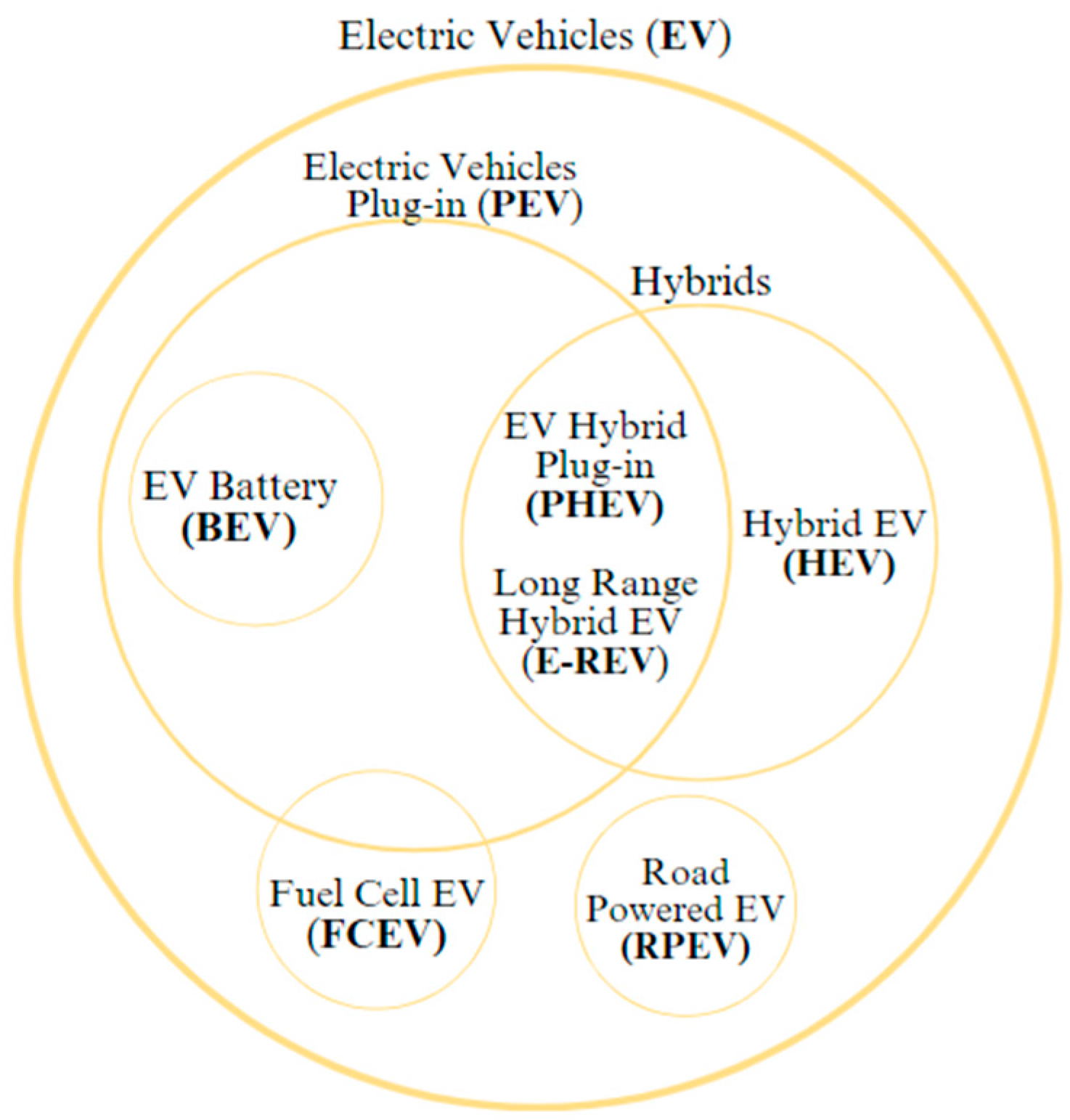
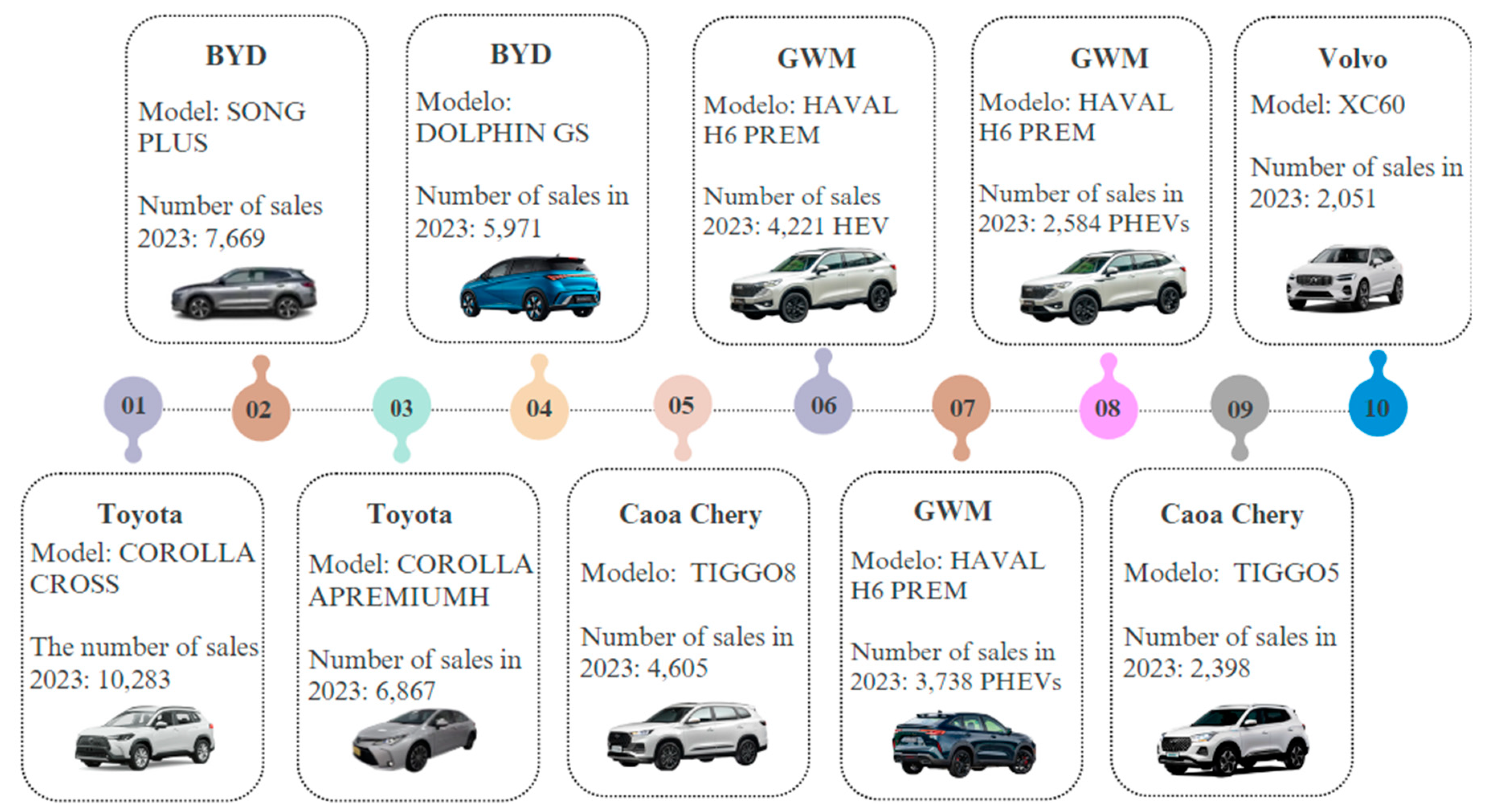
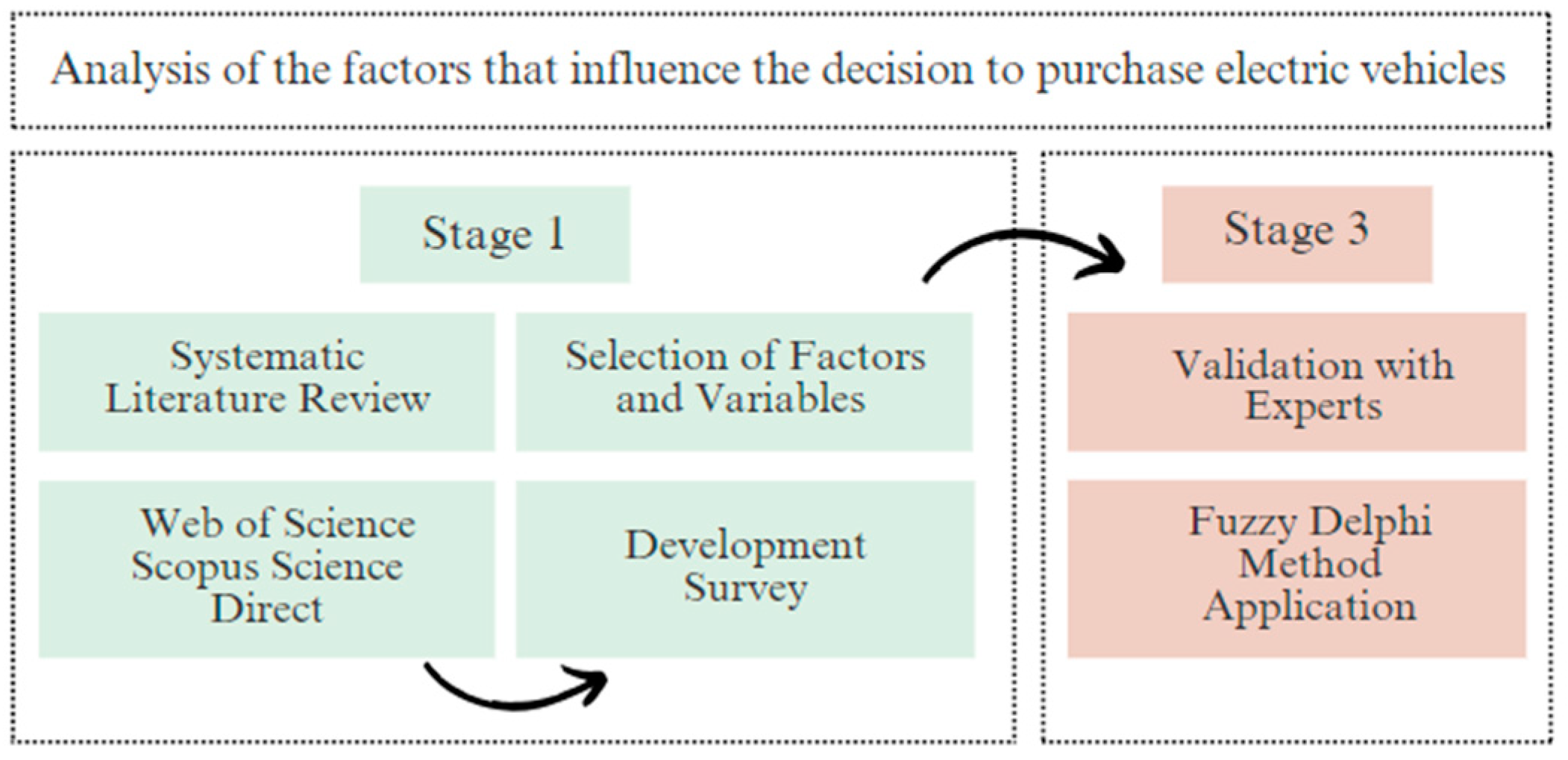
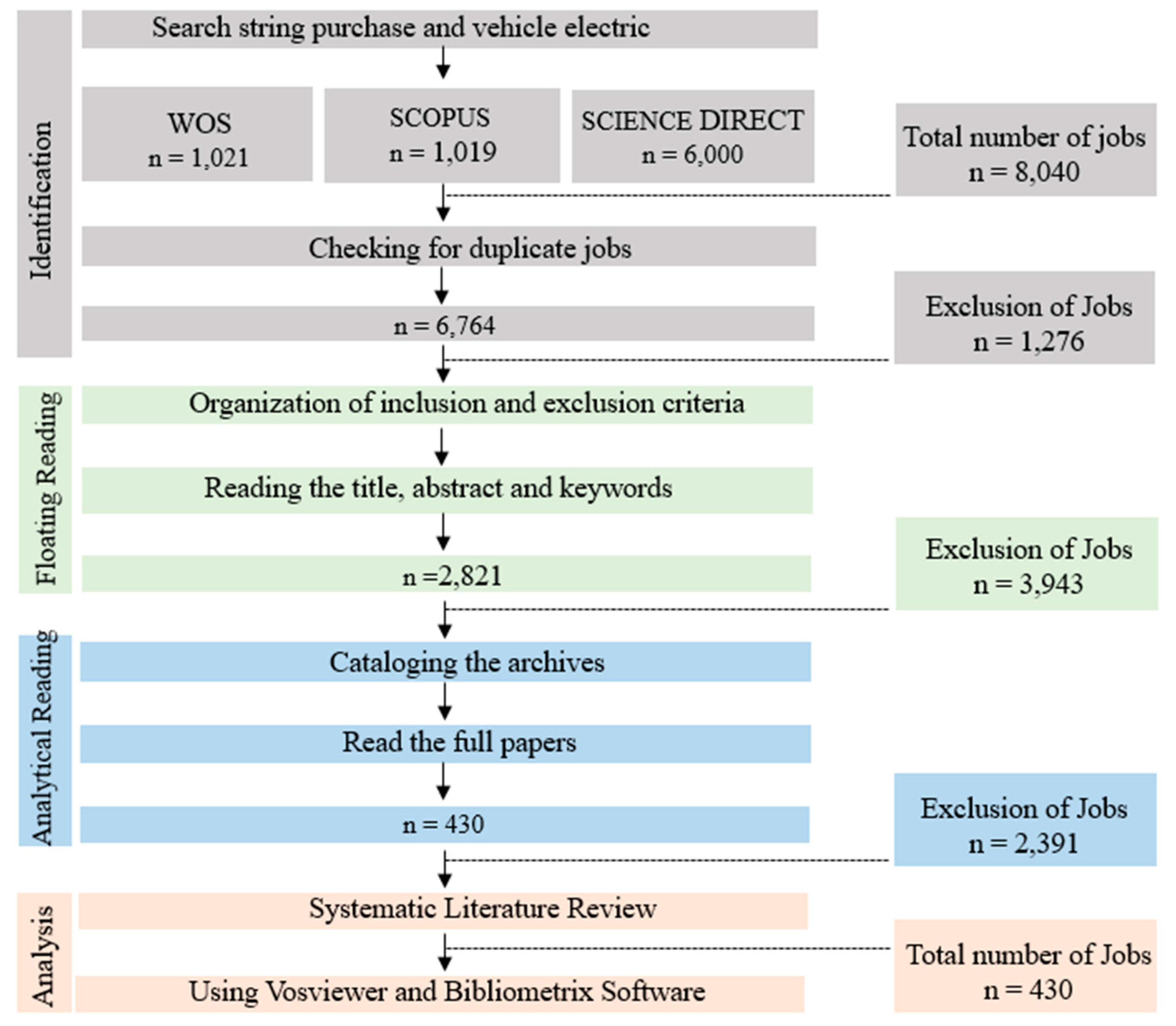

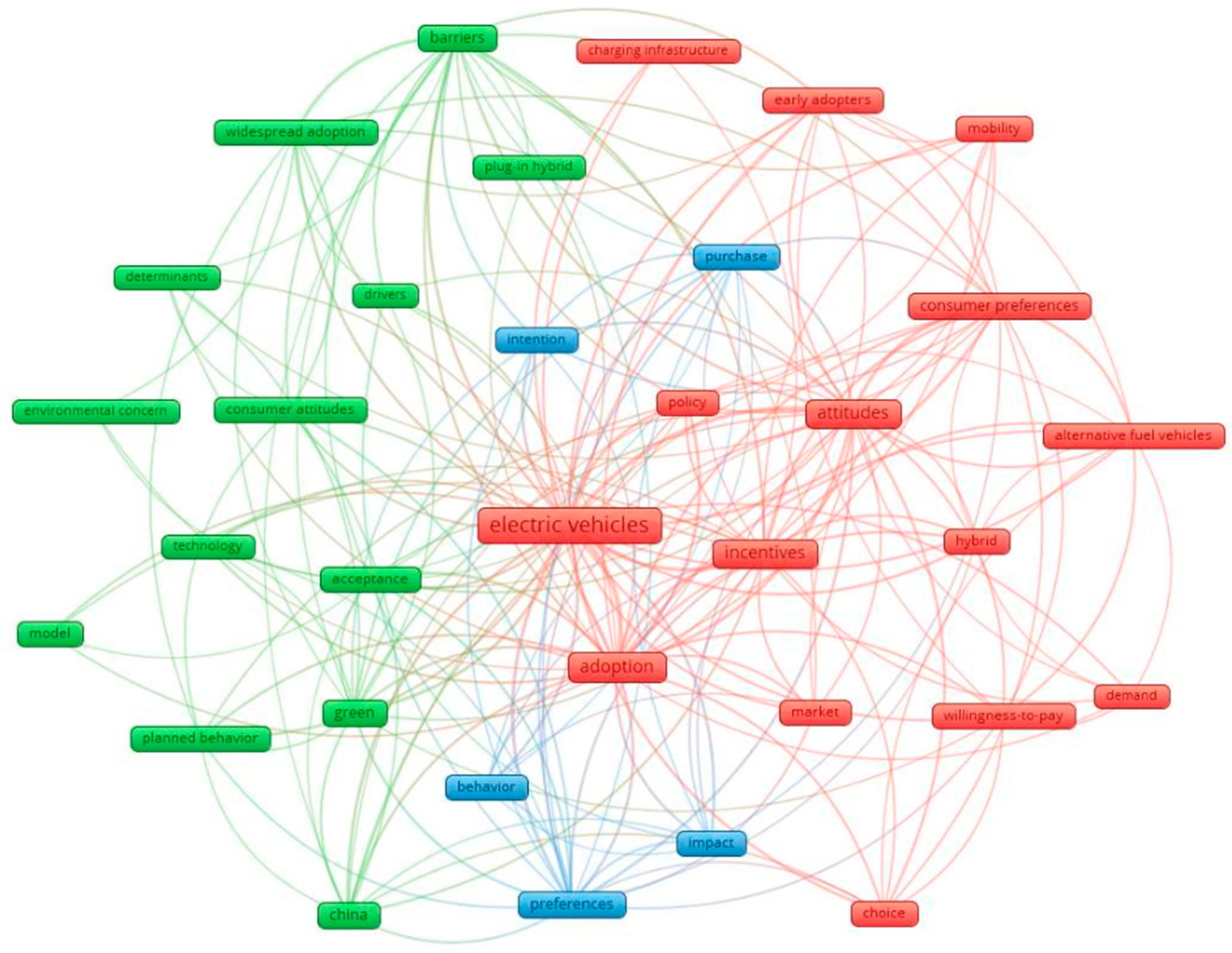
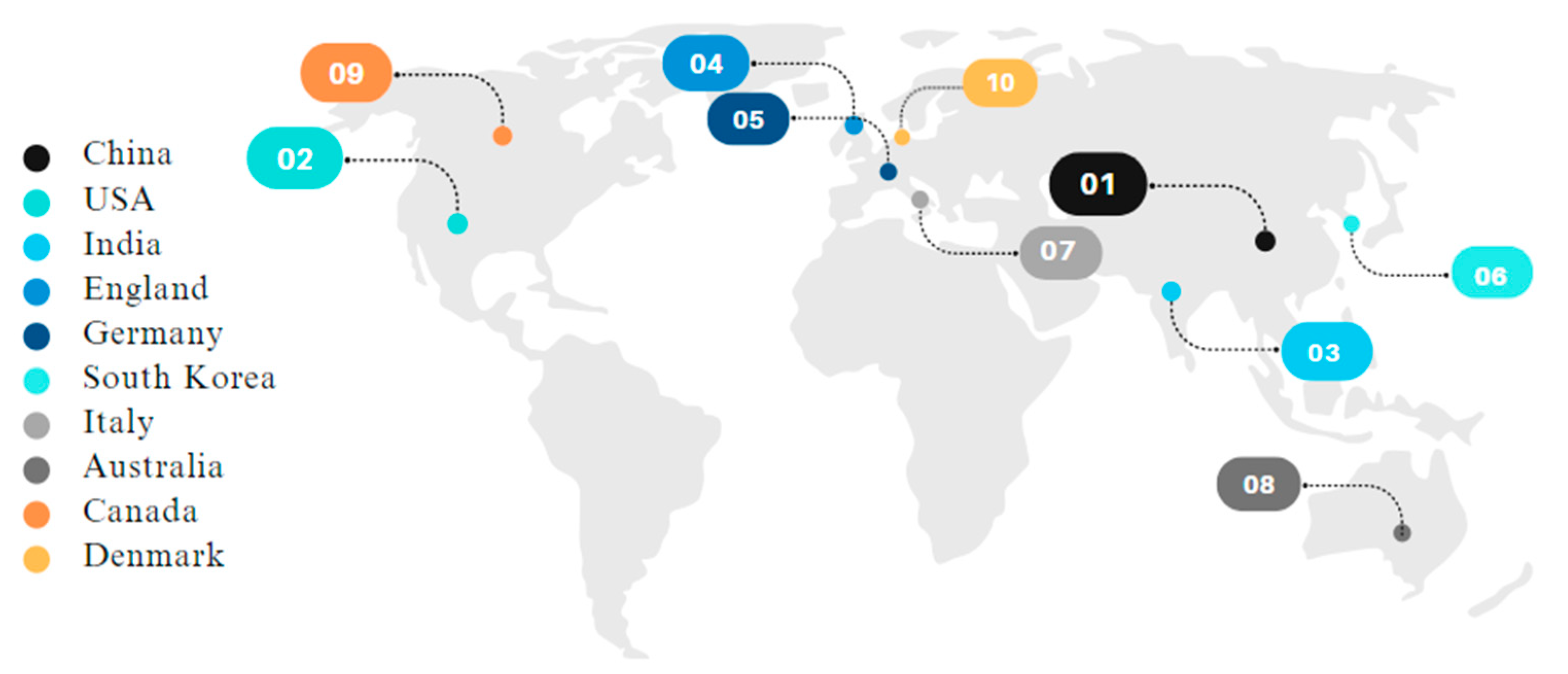
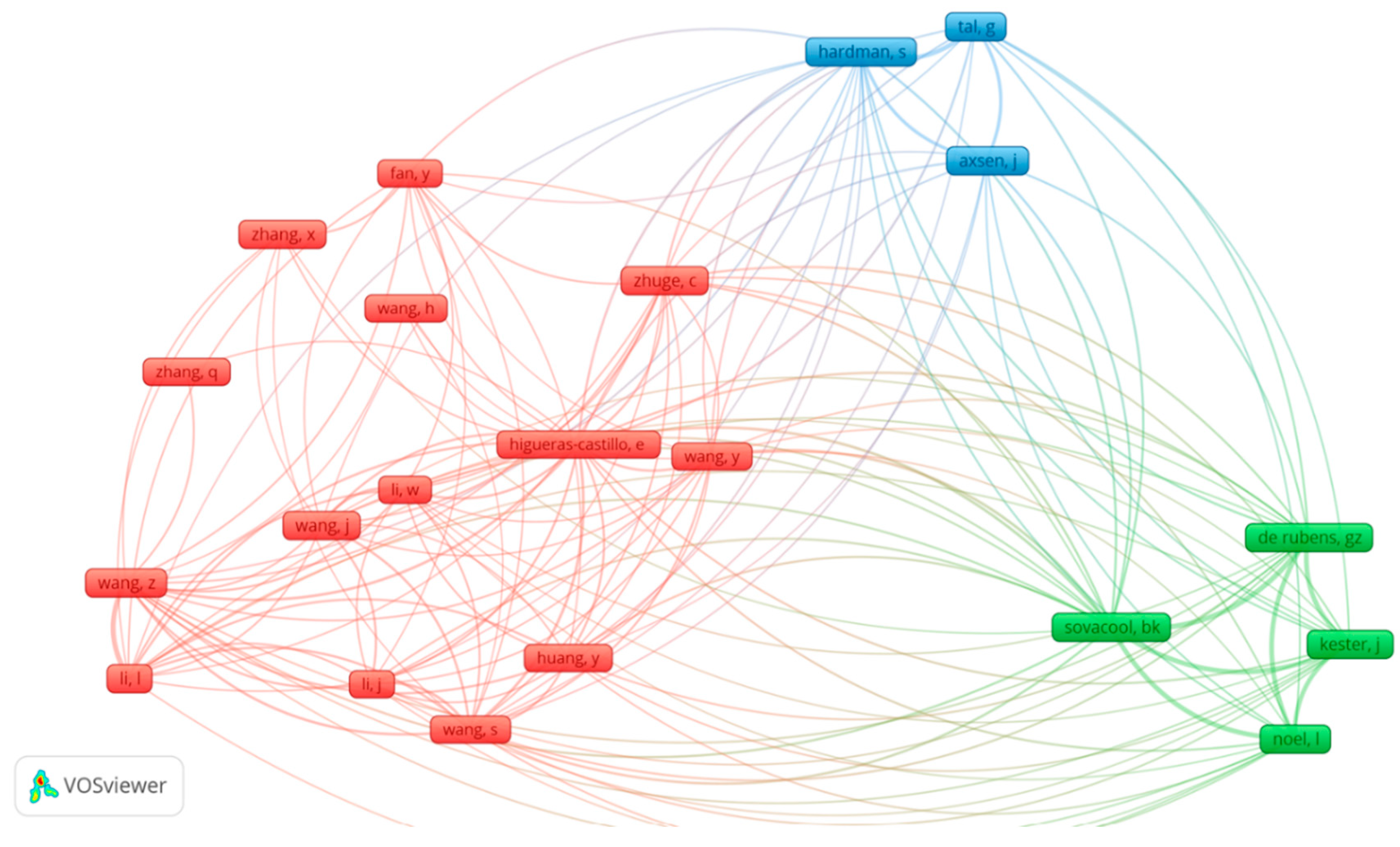
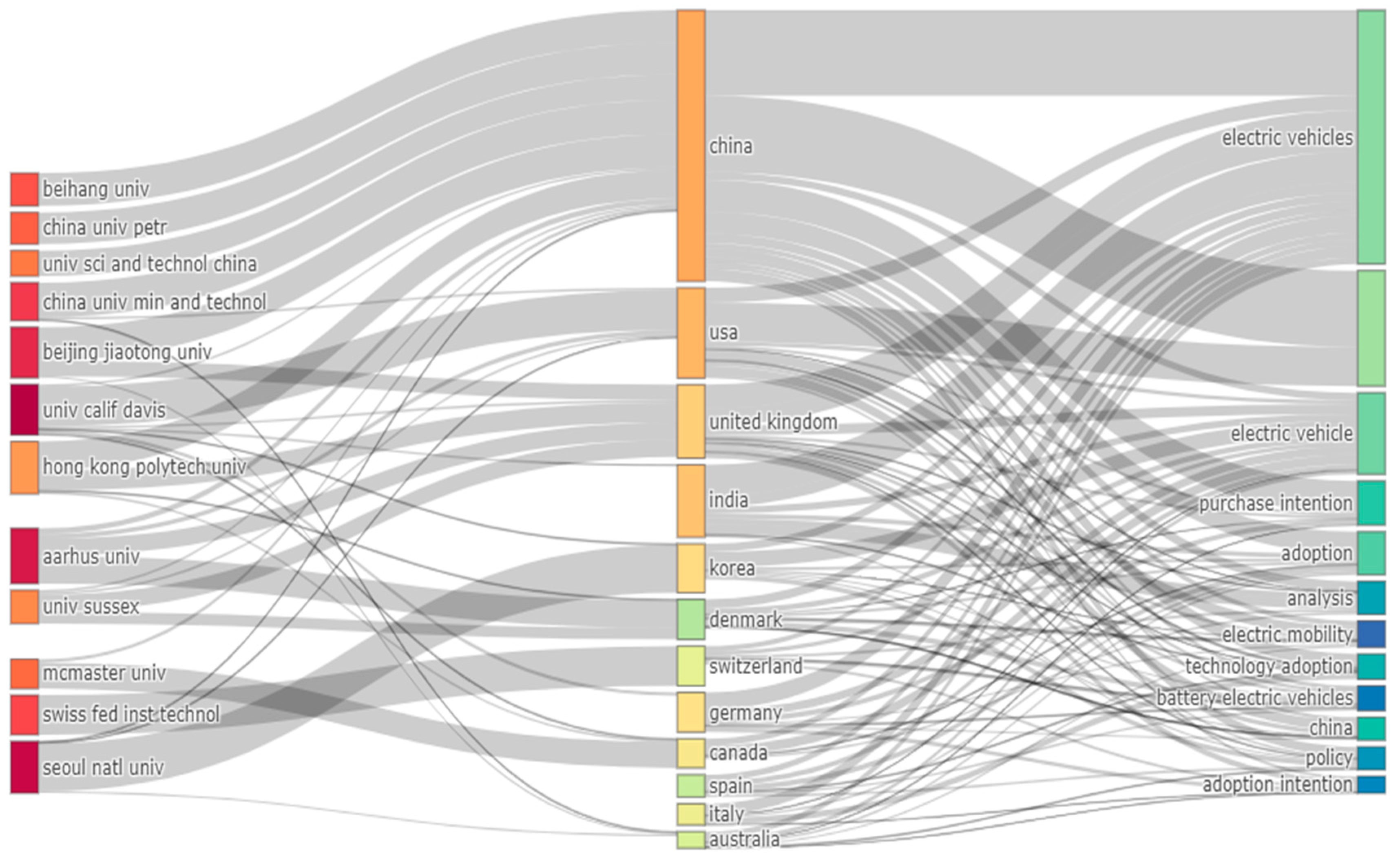

| Block | Factors | Variables | Aj | Bj | Cj | TFN | Value Fuzzific. | Decision |
|---|---|---|---|---|---|---|---|---|
| I | Psychologic | 1.1 | 0.3 | 0.7 | 0.9 | (0.3; 0.7; 0.9) | 0.6 | SELECTED |
| 1.2 | 0.3 | 0.7 | 0.9 | (0.3; 0.7; 0.9) | 0.6 | SELECTED | ||
| 1.3 | 0.3 | 0.8 | 0.9 | (0.3; 0.8; 0.9) | 0.7 | SELECTED | ||
| 1.4 | 0.3 | 0.7 | 0.9 | (0.3; 0.7; 0.9) | 0.6 | SELECTED | ||
| 1.5 | 0.1 | 0.6 | 0.9 | (0.1; 0.6; 0.9) | 0.5 | REJECTED | ||
| II | Economic | 2.1 | 0.5 | 0.8 | 0.9 | (0.5; 0.8; 0.9) | 0.7 | SELECTED |
| 2.2 | 0.3 | 0.8 | 0.9 | (0.3; 0.8; 0.9) | 0.7 | SELECTED | ||
| 2.3 | 0.3 | 0.8 | 0.9 | (0.3; 0.8; 0.9) | 0.7 | SELECTED | ||
| 2.4 | 0.3 | 0.8 | 0.9 | (0.3; 0.8; 0.9) | 0.7 | SELECTED | ||
| 2.5 | 0.1 | 0.8 | 0.9 | (0.1; 0.8; 0.9) | 0.6 | SELECTED | ||
| 2.6 | 0.1 | 0.8 | 0.9 | (0.1; 0.8; 0.9) | 0.6 | SELECTED | ||
| 2.7 | 0.1 | 0.8 | 0.9 | (0.1; 0.8; 0.9) | 0.6 | SELECTED | ||
| 2.8 | 0.5 | 0.8 | 0.9 | (0.5; 0.8; 0.9) | 0.7 | SELECTED | ||
| III | Performance | 3.1 | 0.1 | 0.7 | 0.9 | (0.1; 0.7; 0.9) | 0.6 | SELECTED |
| 3.2 | 0.3 | 0.8 | 0.9 | (0.3; 0.8; 0.9) | 0.7 | SELECTED | ||
| 3.3 | 0.5 | 0.9 | 0.9 | (0.3; 0.9; 0.9) | 0.8 | SELECTED | ||
| 3.4 | 0.3 | 0.8 | 0.9 | (0.3; 0.8; 0.9) | 0.7 | SELECTED | ||
| 3.5 | 0.3 | 0.8 | 0.9 | (0.3; 0.8; 0.9) | 0.7 | SELECTED | ||
| 3.6 | 0.3 | 0.8 | 0.9 | (0.3; 0.8; 0.9) | 0.7 | SELECTED | ||
| 3.7 | 0.5 | 0.8 | 0.9 | (0.5; 0.8; 0.9) | 0.7 | SELECTED | ||
| 3.8 | 0.1 | 0.7 | 0.9 | (0.1; 0.7; 0.9) | 0.6 | SELECTED | ||
| 3.9 | 0.3 | 0.8 | 0.9 | (0.3; 0.8; 0.9) | 0.7 | SELECTED | ||
| 3.10 | 0.3 | 0.8 | 0.9 | (0.3; 0.8; 0.9) | 0.7 | SELECTED | ||
| IV | Environmental | 4.1 | 0.1 | 0.7 | 0.9 | (0.1; 0.7; 0.9) | 0.6 | SELECTED |
| 4.2 | 0.1 | 0.7 | 0.9 | (0.1; 0.7; 0.9) | 0.6 | SELECTED | ||
| 4.3 | 0.1 | 0.7 | 0.9 | (0.1; 0.7; 0.9) | 0.6 | SELECTED | ||
| 4.4 | 0.1 | 0.7 | 0.9 | (0.1; 0.7; 0.9) | 0.6 | SELECTED | ||
| 4.5 | 0.3 | 0.7 | 0.9 | (0.3; 0.7; 0.9) | 0.6 | SELECTED | ||
| 4.6 | 0.3 | 0.7 | 0.9 | (0.3; 0.7; 0.9) | 0.6 | SELECTED | ||
| 4.7 | 0.3 | 0.3 | 0.9 | (0.3; 0.7; 0.9) | 0.7 | SELECTED | ||
| 4.8 | 0.1 | 0.7 | 0.9 | (0.1; 0.7; 0.9) | 0.6 | SELECTED | ||
| 4.9 | 0.3 | 0.3 | 0.9 | (0.3; 0.3; 0.9) | 0.7 | SELECTED | ||
| V | Barriers | 5.1 | 0.1 | 0.5 | 0.9 | (0.1; 0.5; 0.9) | 0.5 | REJECTED |
| 5.2 | 0.1 | 0.8 | 0.9 | (0.1; 0.8; 0.9) | 0.6 | SELECTED | ||
| 5.3 | 0.3 | 0.9 | 0.9 | (0.3; 0.9; 0.9) | 0.7 | SELECTED | ||
| 5.4 | 0.3 | 0.8 | 0.9 | (0.3; 0.8; 0.9) | 0.7 | SELECTED | ||
| 5.5 | 0.3 | 0.8 | 0.9 | (0.3; 0.8; 0.9) | 0.7 | SELECTED | ||
| 5.6 | 0.1 | 0.5 | 0.9 | (0.1; 0.5; 0.9) | 0.5 | REJECTED | ||
| 5.7 | 0.3 | 0.8 | 0.9 | (0.3; 0.8; 0.9) | 0.7 | SELECTED | ||
| 5.8 | 0.1 | 0.7 | 0.9 | (0.1; 0.7; 0.9) | 0.6 | SELECTED | ||
| 5.9 | 0.1 | 0.6 | 0.9 | (0.1; 0.6; 0.9) | 0.5 | REJECTED | ||
| 5.10 | 0.1 | 0.5 | 0.9 | (0.1; 0.5; 0.9) | 0.5 | REJECTED |
Disclaimer/Publisher’s Note: The statements, opinions and data contained in all publications are solely those of the individual author(s) and contributor(s) and not of MDPI and/or the editor(s). MDPI and/or the editor(s) disclaim responsibility for any injury to people or property resulting from any ideas, methods, instructions or products referred to in the content. |
© 2024 by the authors. Licensee MDPI, Basel, Switzerland. This article is an open access article distributed under the terms and conditions of the Creative Commons Attribution (CC BY) license (https://creativecommons.org/licenses/by/4.0/).
Share and Cite
Schvartz, M.A.; Lange Salvia, A.; Londero Brandli, L.; Leal Filho, W.; Veiga Avila, L. The Electric Vehicle Market in Brazil: A Systematic Literature Review of Factors Influencing Purchase Decisions. Sustainability 2024, 16, 4594. https://doi.org/10.3390/su16114594
Schvartz MA, Lange Salvia A, Londero Brandli L, Leal Filho W, Veiga Avila L. The Electric Vehicle Market in Brazil: A Systematic Literature Review of Factors Influencing Purchase Decisions. Sustainability. 2024; 16(11):4594. https://doi.org/10.3390/su16114594
Chicago/Turabian StyleSchvartz, Marceli Adriane, Amanda Lange Salvia, Luciana Londero Brandli, Walter Leal Filho, and Lucas Veiga Avila. 2024. "The Electric Vehicle Market in Brazil: A Systematic Literature Review of Factors Influencing Purchase Decisions" Sustainability 16, no. 11: 4594. https://doi.org/10.3390/su16114594
APA StyleSchvartz, M. A., Lange Salvia, A., Londero Brandli, L., Leal Filho, W., & Veiga Avila, L. (2024). The Electric Vehicle Market in Brazil: A Systematic Literature Review of Factors Influencing Purchase Decisions. Sustainability, 16(11), 4594. https://doi.org/10.3390/su16114594









